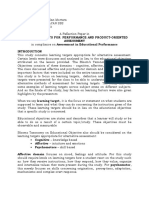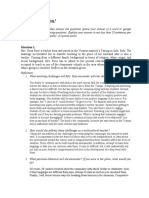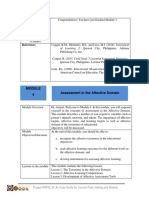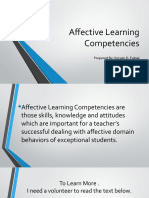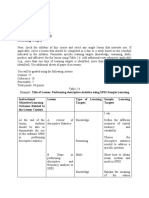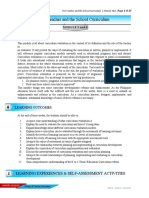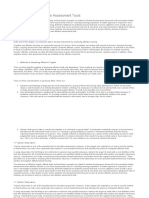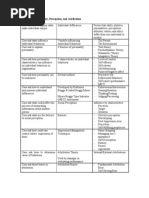Lesson 5 Affective Assessment: Learning Outcomes
Uploaded by
Jayson Kerth Italia SeveroLesson 5 Affective Assessment: Learning Outcomes
Uploaded by
Jayson Kerth Italia SeveroLesson 5 Affective Assessment
Students’ performance is not measured by academic performance alone. Behaviors, attitude
and motivation are affective components of the learners that influences his or her learning.
Affective refers to a wide variety of traits and dispositions that are different from knowledge,
reasoning and manipulative skills (Hohn, 1995). Since the word “affect” is general, it is appropriate that a
teacher will identify specific trait/s or affective skills in developing learning targets. The affective
component involves a child’s feelings / emotions and attitude about a lesson, an activity or a project. A
teacher should consider the learners affective skills that must be develop in order to be effective in their
personal and professional lives.
Learning Outcomes:
1. Define affective assessment.
2. Identify affective components in learning.
3. Determine the levels of affective domains.
4. Formulate objectives in the affective domain.
5. Design assessment tool to assess affective skills.
Importance of Affective Assessment
The affective domain includes a host of constructs like attitude, values, beliefs, interests,
opinions, preference, motivations and a lot more. The affective domain describes learning objectives
that emphasize a feeling, tone, emotion or degree of acceptance or rejection. Affective assessment
does not determine what was learned, instead, it looks into how students feel while they are learning,
and how their learning experiences have influenced their emotions or their future behavior. The
following constructs are usually taken into consideration for assessment of the affective domain:
1. Attitudes. Attitude refers to a person’s reaction (whether negative or positive, favorable or
unfavorable) toward an object, activity, a person or the environment, or in the classroom,
reaction towards learning. On the other hand, attitude cannot be taken solely as an affect.
Learner’s attitude towards a subject, an assignment for example, can be influenced by his or
knowledge of the topic/lesson.
2. Interest. Interest is a psychological state that draws a learner’s attention towards an idea, an
event or an object. Interest drives the learner to be attentive to the topic being discussed and
engaged them in an academic activity in the classroom.
3. Motivation. Motivation is defined as an inner drive, impulse, emotion or desire that moves a
learner to a particular action. Motives arouses and sustains behavior. It may lead to an
increased effort and energy to pursue a goal. Motivation ma be intrinsic or extrinsic (Santrock,
2005). There are six needs and desires that are integral to motivation (Ausubel, 1968): the need
to explore; the need to manipulation or for manipulation; the need for activity or to be active;
the need for stimulation; the need for knowledge and the need for ego enhancement.
According to Ausubel, aside from these needs and desires, meaningful learning can only be
achieved if learners can relate new knowledge to their existing knowledge.
4. Self-confidence. Self-confidence is the learner’s perception of his or her capabilities to
accomplish the task given to him or to her. Studies revealed that students’ academic
achievement is associated with the students’ academic success.
5. Values. Values include principles that an individual considers to be right, and consequently
guides the individual’s future actions and decision making. Some teachers would look into some
of their students’ values like honesty, respect for others, courtesy, patience, cleanliness,
orderliness, industry, being helpful, care for the environment and others.
6. Beliefs. Beliefs are traditionally associated with religion. It refers to a person’s conviction or
opinion that he or she holds true even without evidence. Oftentimes, beliefs are discussed in
the classroom such as their beliefs about freedom, peace, marriage, gender equality, and other
beliefs that may arise in the course of discussion.
7. Locus of Control. Locus of control refers to one’s perception of whether success is controlled by
the student or by external influences.
8. Moral Development. It is the attainment of ethical principles that guide decision-making
behavior.
9. Emotional Development. It reflects change and awareness of emotions and the ability to
regulate emotional expression.
10. Social Relationships. It is the nature of interpersonal interactions and functioning in group
setting.
11. Altruism. It is the willingness and propensity to help others.
The Affective Learning Targets
The affective learning targets vary from simple attention to selected complex but internally
consistent qualities of character and conscience. The levels of affective domain emphasize a feeling,
tone, emotion, or degree of acceptance or rejection. It has five levels of affective targets which the
teacher may use to target learner behavior that can be assessed at the end of the lesson.
Level 1. Receiving (Attention). Attention can be assessed through interest inventories and can
be rated using the Likert Scale. Attention refers to the student’s willingness to attend to a classroom
activity under the direction of a teacher.
Level 2. Responding (Interest). Interest can be shown by the active participation of the learners
in class discussion, volunteering for tasks, enjoys helping others and willingness to answer questions.
Level 3. Valuing (Preference/Appreciation). Preference or appreciation can be shown on the
students’ general reaction to questions that the teacher gets from his or her learners Students may
express strong opinions on the topic being discussed, show concern for the welfare of others, and
demonstrate commitment to social improvement. Preference of appreciation can be measured
through a Likert Scale with a scale ranging from Strongly Agree to Strongly Disagree with Undecided
in the middle.
Level 4. Organization (Philosophy of Life). Accepting responsibility for his or behavior,
understanding and accepting own strengths and weaknesses, and formulating life plan in harmony
with his or her abilities, interests and beliefs.
Level 5. Characterization by Value (Lifestyle). When a student can work independently,
cooperate in group activities demonstrates punctuality and self-discipline and consistency of his
daily actions is demonstrating a value-laden lifestyle.
Application
1. Apply the concepts discussed on affective learning targets. Using the levels of learning targets
the affective domain, write at least two measurable affective targets/objectives. Follow the
format given below. Write your answer in a separate sheet of paper (For modular learning)
For online learning, submit the same in our e-classroom.
Levels Measurable Affective Objective
Receiving (Attending) 1.
2.
Assessment
Write your own ideas about the importance of affective targets. Below are your guide questions.
Follow the same manner of submission.
1. Why is affective target important?
__________________________________________________________________________________
__________________________________________________________________________________
______________________________________________________________________________.
2. What problems can I anticipate in setting affective targets?
__________________________________________________________________________________
__________________________________________________________________________________
_____________________________________________________.
3. How will the students benefit from the affective targets?
__________________________________________________________________________________
__________________________________________________________________________________
__________________________________________________________________.
You might also like
- Basic Concepts, Theories, and Principles in Assessing Learning (Alternative Methods)0% (1)Basic Concepts, Theories, and Principles in Assessing Learning (Alternative Methods)13 pages
- Assessment - Essential Elements of PortfolioNo ratings yetAssessment - Essential Elements of Portfolio2 pages
- Purposes of Instructional Goals and ObjectivesNo ratings yetPurposes of Instructional Goals and Objectives8 pages
- Affective Learning Competencies: Educ106.2 - MR - Dennis Ubenia Bsed-Eng - Educ3BNo ratings yetAffective Learning Competencies: Educ106.2 - MR - Dennis Ubenia Bsed-Eng - Educ3B48 pages
- CHAPTER 3 Learning Outcome Sources and CharacteristicsNo ratings yetCHAPTER 3 Learning Outcome Sources and Characteristics13 pages
- Product-Oriented, Performance-Based AssessmentNo ratings yetProduct-Oriented, Performance-Based Assessment9 pages
- IG Responding To The Needs of A Culturally DiverseNo ratings yetIG Responding To The Needs of A Culturally Diverse10 pages
- Nature, Purpose and Rationale for Assigning GradesNo ratings yetNature, Purpose and Rationale for Assigning Grades11 pages
- Learning Targets For Performance and Product-Oriented Assessment100% (1)Learning Targets For Performance and Product-Oriented Assessment2 pages
- Name: Date: Year and Section: Subject: Assessment of Learning 250% (2)Name: Date: Year and Section: Subject: Assessment of Learning 27 pages
- Types of Assessment Brief Description Advantages and Disadvantages Classroom ApplicationNo ratings yetTypes of Assessment Brief Description Advantages and Disadvantages Classroom Application5 pages
- 4 Assessment in The Affective Domain: ReferencesNo ratings yet4 Assessment in The Affective Domain: References20 pages
- Activity 1.2 - Comparing and Contrasting The Models: (Adapted and Modified From Bilbao Et Al., 2015)No ratings yetActivity 1.2 - Comparing and Contrasting The Models: (Adapted and Modified From Bilbao Et Al., 2015)3 pages
- EDUC 60: The Teacher and The Community, School Culture and Organizational Leadership Learning Activity 2: Philosophical Thoughts On EducationNo ratings yetEDUC 60: The Teacher and The Community, School Culture and Organizational Leadership Learning Activity 2: Philosophical Thoughts On Education3 pages
- I. Activities/Assessment:: Activity 1: Assessment Scenarios (3 Points Each)100% (3)I. Activities/Assessment:: Activity 1: Assessment Scenarios (3 Points Each)13 pages
- III E1 Product Oriented Perfomance Based Assessment100% (1)III E1 Product Oriented Perfomance Based Assessment36 pages
- Curriculum Leadership Is The Process of Taking Charge or Demonstrating The Initiative Towards Significant100% (1)Curriculum Leadership Is The Process of Taking Charge or Demonstrating The Initiative Towards Significant2 pages
- MOdule 2 - Timetabling-Multi-grade TeachingNo ratings yetMOdule 2 - Timetabling-Multi-grade Teaching16 pages
- AL 4.1 - Utilization of Assessment DataNo ratings yetAL 4.1 - Utilization of Assessment Data10 pages
- Lesson 2: Implementing A Curriculum Daily in The Classrooms: Presented By: Elaine R. Mateo Bsed Iii-EnglishNo ratings yetLesson 2: Implementing A Curriculum Daily in The Classrooms: Presented By: Elaine R. Mateo Bsed Iii-English41 pages
- Chapter 3: Organization, Utilization, and Communication of Test ResultsNo ratings yetChapter 3: Organization, Utilization, and Communication of Test Results25 pages
- Test According To The Nature of Answer - GupaalNo ratings yetTest According To The Nature of Answer - Gupaal9 pages
- Lesson 6. Techniques in Testing Reliability of Assessment Method: Split - Half and Internal Consistency MethodsNo ratings yetLesson 6. Techniques in Testing Reliability of Assessment Method: Split - Half and Internal Consistency Methods8 pages
- Cal/ Cale/ Calm Performance-Based AssessmentNo ratings yetCal/ Cale/ Calm Performance-Based Assessment24 pages
- Unit 3: Authentic Assessment o F The Affective Domain (Affective Targets)No ratings yetUnit 3: Authentic Assessment o F The Affective Domain (Affective Targets)18 pages
- Chapter 2 Learning Targets For Performance and Product-Oriented Assessment100% (1)Chapter 2 Learning Targets For Performance and Product-Oriented Assessment29 pages
- Affective, Sensory and Empathic Sharing of Another's Pain - The Empathy For Pain Scale (2015)No ratings yetAffective, Sensory and Empathic Sharing of Another's Pain - The Empathy For Pain Scale (2015)10 pages
- A Componential Model of Science Classroom Creativity (SCC) ForNo ratings yetA Componential Model of Science Classroom Creativity (SCC) For15 pages
- Couples Specific Couple Therapy TechniquesNo ratings yetCouples Specific Couple Therapy Techniques10 pages
- Unthought Meets The Assemblage Brain PDFNo ratings yetUnthought Meets The Assemblage Brain PDF25 pages
- Ch3 - Personality, Perception and Attribution FinNo ratings yetCh3 - Personality, Perception and Attribution Fin11 pages
- Child Psychology Psychiatry - 2006 - Nigg - Temperament and Developmental PsychopathologyNo ratings yetChild Psychology Psychiatry - 2006 - Nigg - Temperament and Developmental Psychopathology28 pages
- Aertsens 2009 Personal Determinants of ORGANIC FOOD CONSUMPTIONNo ratings yetAertsens 2009 Personal Determinants of ORGANIC FOOD CONSUMPTION28 pages
- (Mora & McAndrew, 2003) - Common-Sense Model of Self-Regulation.No ratings yet(Mora & McAndrew, 2003) - Common-Sense Model of Self-Regulation.8 pages
- Get Horror Film and Affect Towards a Corporeal Model of Viewership 1st Edition Xavier Aldana Reyes free all chapters100% (1)Get Horror Film and Affect Towards a Corporeal Model of Viewership 1st Edition Xavier Aldana Reyes free all chapters55 pages
- Learning Skill: Dr. Jayalangkara Tanra SP - KJNo ratings yetLearning Skill: Dr. Jayalangkara Tanra SP - KJ21 pages




























